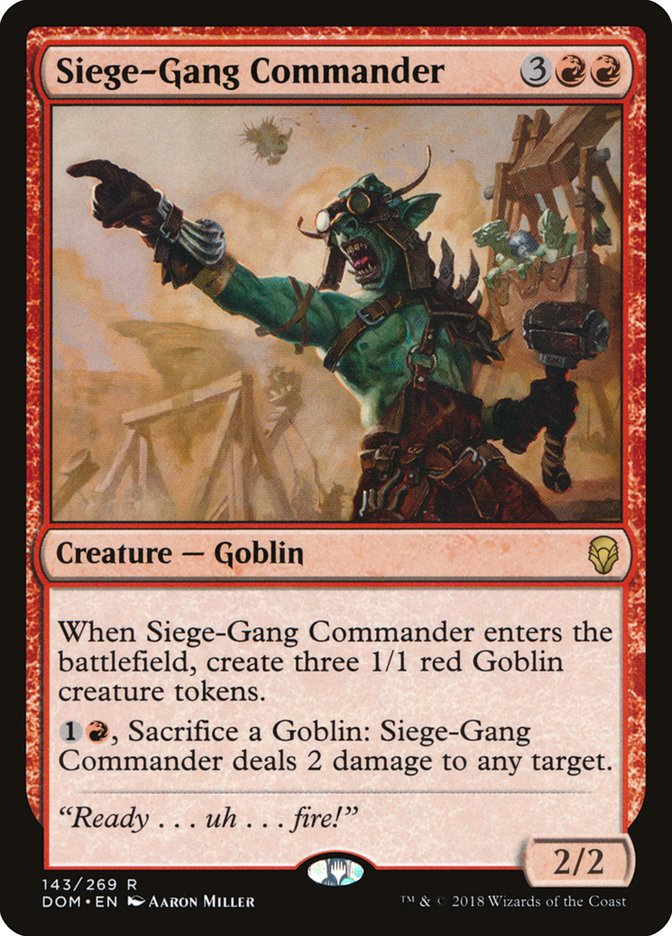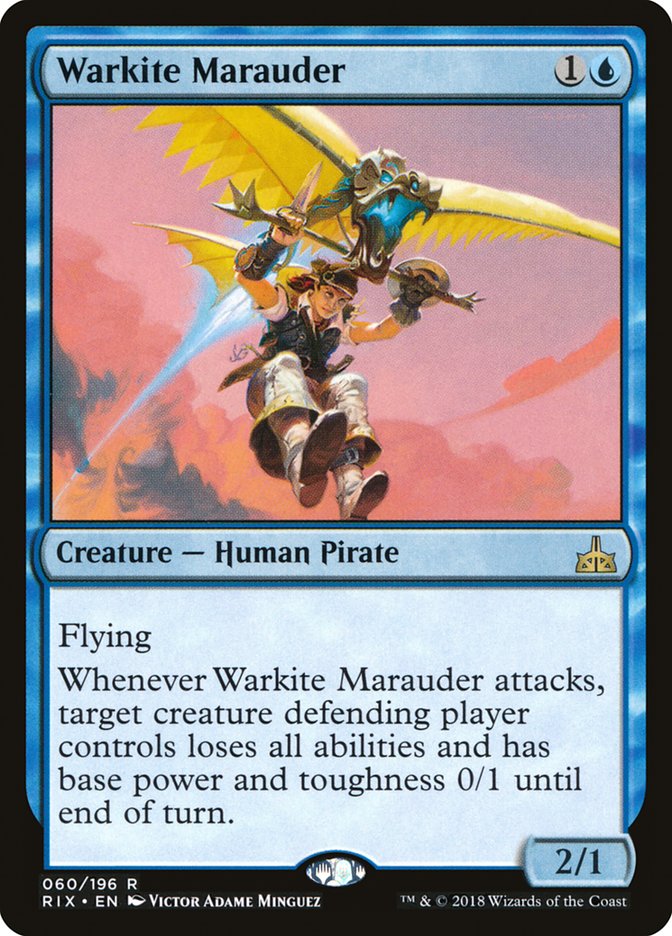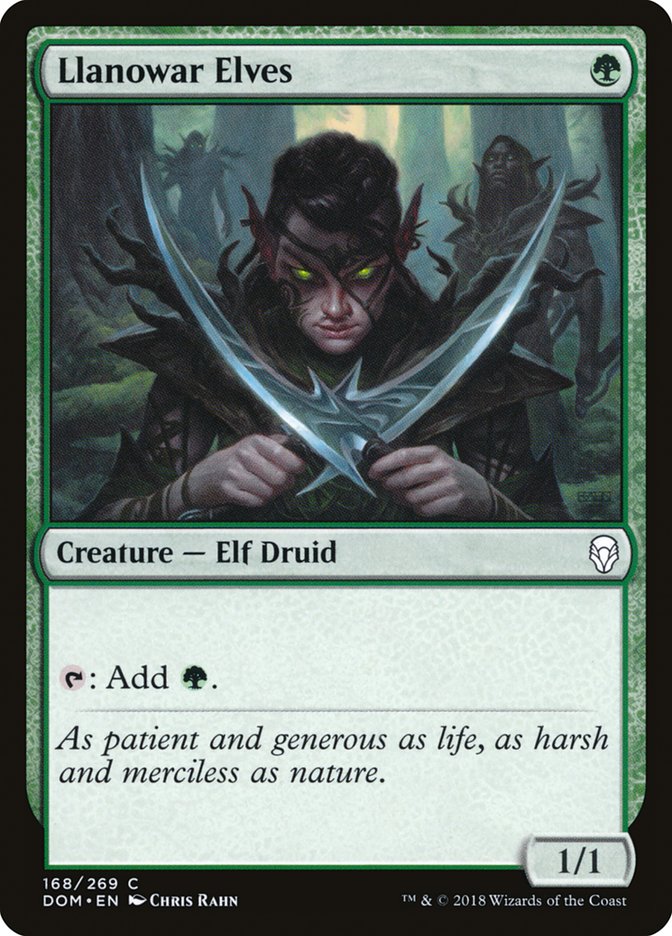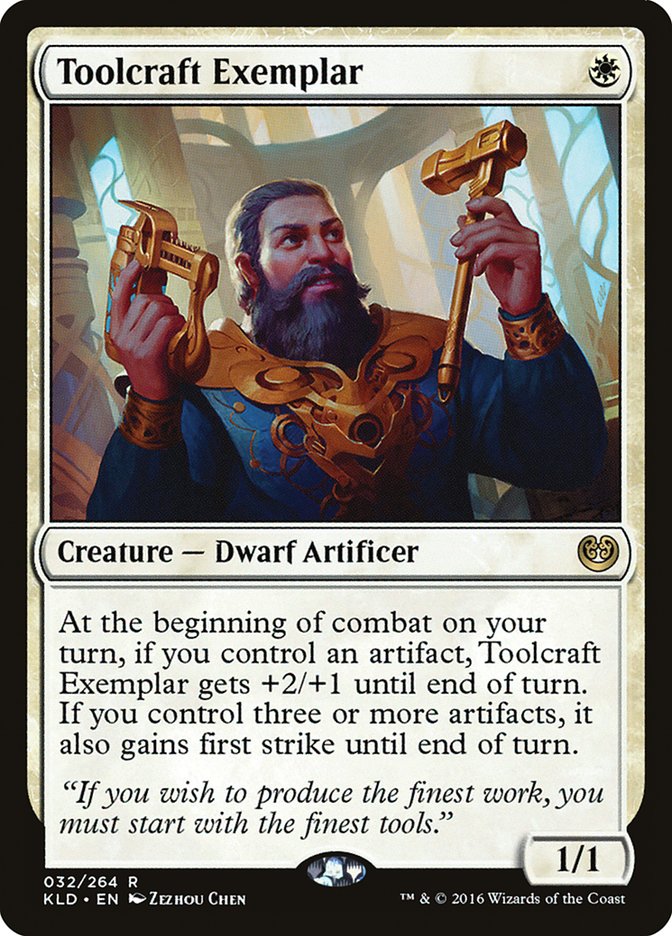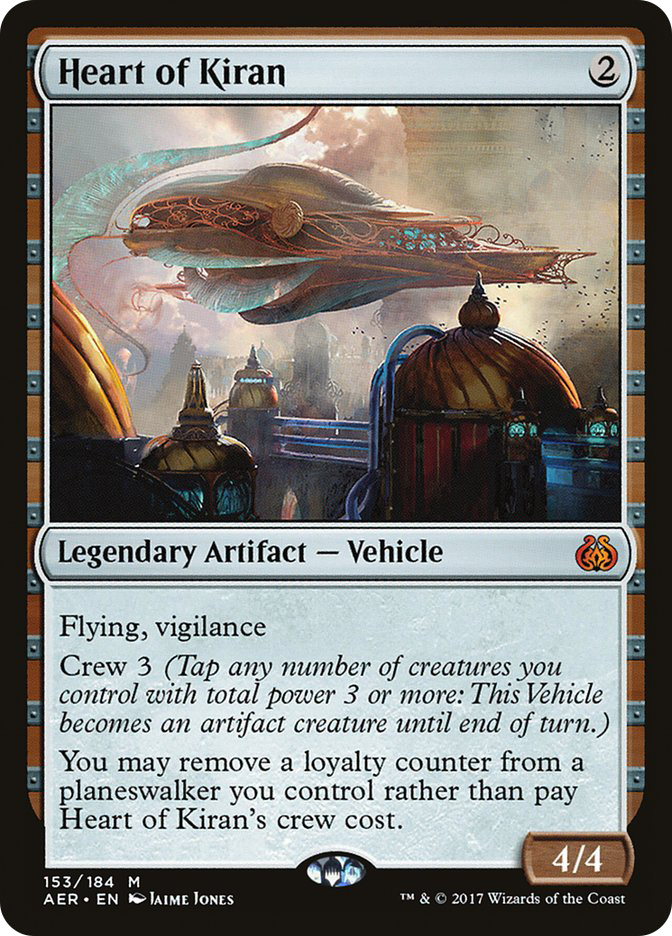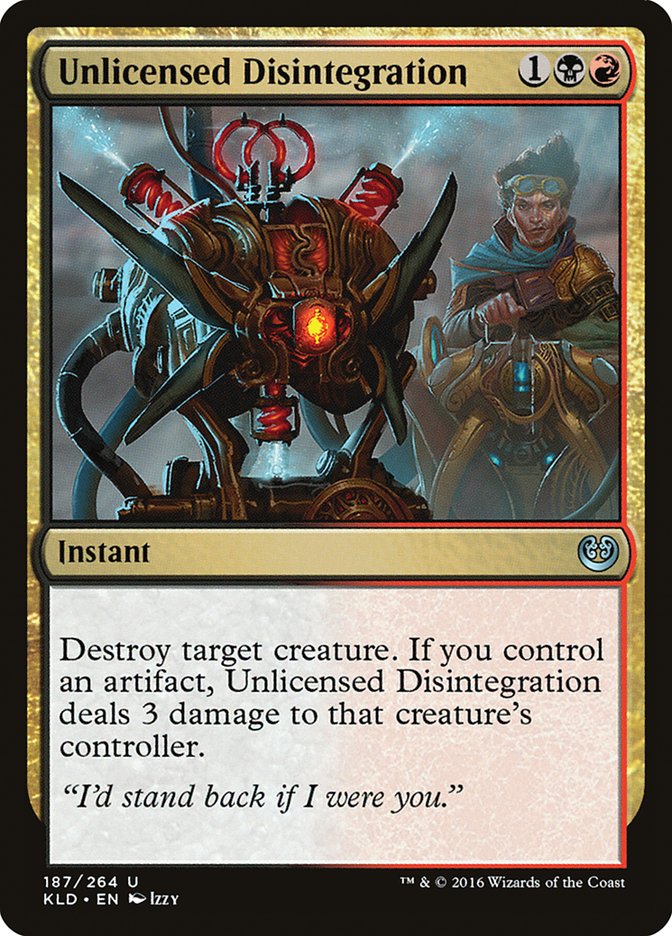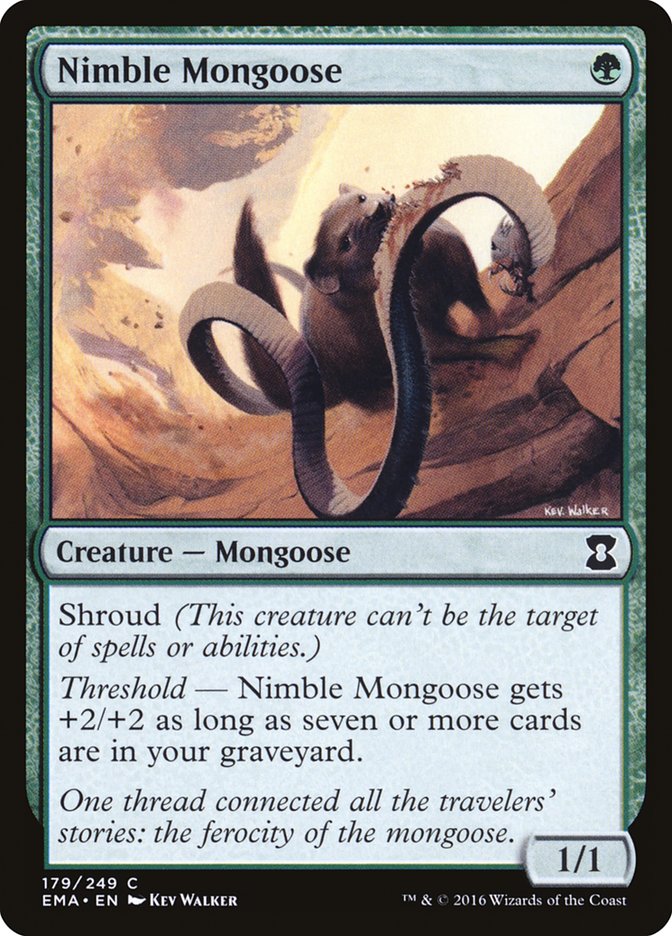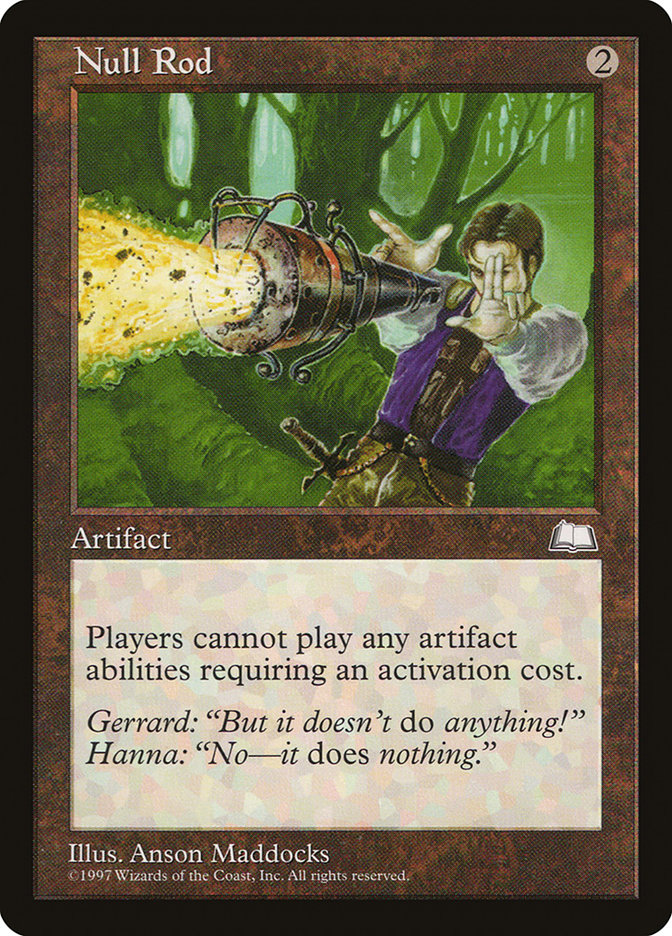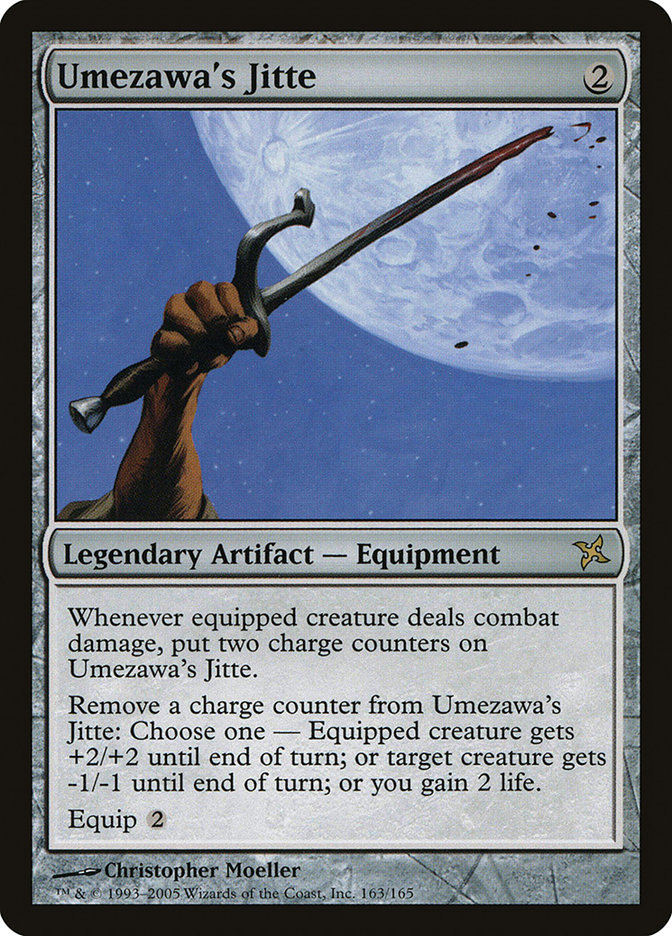First things first: last week I promised a Standard decklist with Warkite Marauder, and I intend to deliver on that promise. Meet the Grand Prix Seattle-winning deck (assuming, of course, that not everyone who intends to play it in Standard does well enough in Legacy to stay in the first GP):
Creatures (32)
- 4 Bomat Courier
- 4 Minister of Inquiries
- 2 Trophy Mage
- 4 Walking Ballista
- 4 Combat Celebrant
- 2 Vizier of Many Faces
- 4 Champion of Wits
- 4 Fanatical Firebrand
- 4 Warkite Marauder
Lands (22)
Spells (6)

Pretty straightforward. Warkite Marauder blanks The Scarab God, Rekindling Phoenix, Hazoret the Fervent, and just about every other beefcake in Standard. In concert with Fanatical Firebrand and Walking Ballista, the Marauder does some truly dirty things. With a creature count of 32, this deck has an easy time getting the requisite six friends in the graveyard to bring the Gift to the party.
The addition of an extra 2/1 flying attacker also helps put the “nickel and dime” plan to beat many control decks over the line of plausibility, and many a game has ended with a Spell Pierce on a Vraska’s Contempt that would otherwise have stabilized against a few aggressive Limited-quality creatures. Padeem, Consul of Innovation makes cards like Abrade, Thrashing Brontodon, and Naturalize look positively wimpy and provides a well-proportioned toughness to happily block most of the creatures in the red and black aggressive decks. In short, it’s perfect.
As Ari Lax mentioned in his excellent send-off to this Standard format, though, there isn’t much to be done with the format after a few lingering events. There’s only a short while for this particular iteration of the deck to shine. Fortunately, or unfortunately, we’ve got Dominaria on the horizon, and that means new toys for Nicol Bolas to wrap up for good little children in shiny 4/4 hasty packages.
The first obvious candidate for gift-wrapping is none other than Siege-Gang Commander, a good little Goblin who brings enough friends to the party to make sure that everything gets blown up. In concert with Warkite Marauder, a bucketful of Goblins is essentially a Plague Wind, and the fact that Siege-Gang clogs up a battlefield so well on both the front side and the zombified side means that it’s going to be among the first cards to jump into new versions of the archetype.
A little less obvious is Llanowar Elves, which serves an incredibly important purpose for God-Pharaoh’s Gift decks. It’s an expendable early body that powers out Turn 2 Gate to the Afterlife and Turn 6 eternalized Champion of Wits (or hard-cast God-Pharaoh’s Gift) with equal ease. With the addition of the enemy checklands, Temur or Sultai Gift could become a powerful deck, incorporating Servant of the Conduit and Llanowar Elves to bring on some busted openings. Let’s examine a tentative maindeck for a hypothetical Sultai version:
Creatures (31)
- 4 Llanowar Elves
- 4 Servant of the Conduit
- 4 Minister of Inquiries
- 2 Trophy Mage
- 4 Glint-Sleeve Siphoner
- 4 Walking Ballista
- 2 The Scarab God
- 4 Champion of Wits
- 3 Hostage Taker
Lands (23)
Spells (6)

There are tons of other considerations here, including Deathgorge Scavenger as a source of lifegain and semi-mirror disruption, Fatal Push or Moment of Craving as extra removal if needed, and the omnipresent sideboard countermagic. For now, bask in the glow of the mana creatures that enable this strategy, cards so powerful at accelerating the deck’s gameplan that they justify splashing a color by themselves!
Bant, Temur, Sultai…all are valuable options for Gift decks now that Llanowar Elves has made its imposing presence known in Standard. However, I would be remiss not to mention that there are several payoffs and engines surrounding artifacts in this set, which means that it may be high time to tinker with Glint-Nest Crane, The Antiquities War, and the heaping helping of Historic cards that are available for use.
Creatures (17)
Planeswalkers (4)
Lands (22)
Spells (17)

Now, the not-so-well-kept secret in this deck is how broken Karn, Scion of Urza’s -2 ability is. These Constructs are unbelievably big, unbelievably quickly. But let’s be real: this assortment of neat artifacts isn’t going to start crushing any tournaments. It’s got a lot of holes that need to be patched. The deck is playing Merchant’s Dockhand and Prophetic Prism, for crying out loud!
I distinctly remember a Raphael Levy brew from Pro Tour Hour of Devastation that incorporated Glint-Nest Crane in Mardu Vehicles, and it’s the most exciting old-new deck to come out of Dominaria. If you want to get your opponent dead, this is the most “real” way to abuse the best planeswalker since Gideon, Ally of Zendikar.
Creatures (18)
Planeswalkers (4)
Lands (24)
Spells (14)
Sideboard

The deck would function perfectly well as a straight Mardu list, and it may not be worth stretching the manabase for a few blue cards. Pia Nalaar is crying out to be included in this beautiful mess of a deck, and it might be well worth it to include her. The manabase would appreciate it as well.
Karn is just so darn powerful that the Vehicles archetype could be completely revitalized, as it’s the deck best poised to take advantage of a pair of fat Constructs and a planeswalker to pilot the Heart of Kiran. If Mono-Red Aggro got everyone on board with the brokenness that is a curved-out Hazoret the Fervent, Mardu Vehicles is going to re-acquaint everyone with the brokenness that is the curve-out of Toolcraft Exemplar / Heart of Kiran / Unlicensed Disintegration / powerful planeswalker.
Disgusting.
Speaking of disgusting, there’s another format being dominated by another powerful card on display this weekend, a card that many have playfully termed Magic’s first and only “one-mana planeswalker.” You know this little Elf as Deathrite Shaman, and Legacy is in its thrall.
Should Deathrite Shaman be banned? We’ll get to have that discussion soon enough; I expect that the results from this GP will be fairly damning. If Sensei’s Divining Top was too dominant in Miracles, it makes sense that Deathrite Shaman in Grixis Delver, Sultai Delver, Four-Color Control, Shardless Sultai, Elves, and a slew of less-popular decks is similarly deserving of a ban.
Even the other decks in the format are heavily warped to try to combat the ubiquitous mana creature. Miracles is playing Back to Basics in an attempt to shut off the all-nonbasic manabase of most Deathrite decks; Lands (of course) plays piles of Wastelands, Punishing Fire, and the Dark Depths combo to properly combat fair Deathrite decks; and we’ve even seen an uptick in Mono-Red Prison trying to end the game before it even starts with chuckle-worthy openings like Turn 1 Blood Moon.
In short, Legacy has devolved into Deathrite decks; unfair decks (Sneak and Show, Storm, and Reanimator); and semi-fair decks that try to cheese out wins against the nonbasic-heavy manabase of Grixis Delver. Is this entirely healthy? Not really. Is it survivable? Sure, it’s fine. It’s not the greatest Legacy’s ever been, but there are still numerous adequate archetypes for players of all experience levels.
What would happen, though, if Deathrite were to go? If we imposed a little austerity on our manabases? What would we see? Esper StoneBlade, Miracles, Landstill, Grixis Control, and Thopter-Sword decks would all emerge as powerful contenders, where now we only see basic-heavy Miracles as the clear best choice.
Reanimator, Dredge, and Lands would all experience a powerful resurgence before people started packing large quantities of Surgical Extraction, Rest in Peace, or Leyline of the Void in their sideboards again. Mono-Red Prison would likely fall out of fashion as more basic Plains and sideboard Disenchants clean up the riffraff. Cards like Leovold, Emissary of Trest would fall precipitously out of vogue, as their best enabler goes AWOL. U/R Delver (possibly with Bedlam Reveler as a fake Treasure Cruise) would pick up some of the slack.
Of course, Temur Delver would once again emerge as the premier tempo deck for people who want to play low-resource games and grief their opponents through Stifle and Wasteland. Most of all, a new golden age for Nimble Mongoose and Tarmogoyf would arrive. Without omnipresent graveyard pressure, these erstwhile “best pseudo-blue creatures in Legacy” would once again inherit the throne that was rightfully theirs.
And if Wizards does decide to make this little shake-up happen right on the eve of the Team Pro Tour to throw a little curveball at some complacent pro players, I wouldn’t shed a single tear. It would be an opportunity to flex some long-atrophied Stoneforge Mystic muscles, and my copies have been sitting in my binder a little too long.
For now, though, it’s Delver of Secrets for breakfast, lunch, and dinner in Legacy. And there are a few cards that have not been seeing enough play in these Delver decks, whether they incorporate Young Pyromancer, Snapcaster Mage, extra Gurmag Anglers, Hymn to Tourach and Tombstalker, or some other mix of threats and disruption.
The first is Liliana, the Last Hope. As a cross between an Izzet Staticaster / Grim Lavamancer effect, a Kolaghan’s Command effect, and an Endless Ranks of the Dead effect, Liliana has applications against decks as varied as Elves and Miracles, Four-Color Control and Death and Taxes. This card embarrasses Baleful Strix and Young Pyromancer while presenting answer-light Miracles opponents with a ticking time bomb that often runs away with a game. Play two in your sideboard and thank me later.
The next is Null Rod. The cross-applications here are fairly straightforward. Storm loses use of its Lotus Petals and Lion’s Eye Diamonds. Death and Taxes loses use of Aether Vial and Equipment. The smattering of big-mana Eldrazi decks lose use of their Grim Monoliths, Voltaic Keys, Thran Dynamos, and the like.
Most Grixis Delver lists appear slightly under-sideboarded for Storm as opposed to Sneak and Show (where the Pyroblasts and Diabolic Edicts are adequate sideboard material). The permanent-based disruption complements stack-based disruption nicely, as Storm opponents often rely on sculpting a hand for a big buildup turn and using a same-turn Cabal Therapy to clear the way for their combo. Of course, there’s no harm in helping the Death and Taxes matchup without needing a card dedicated solely to that narrow deck, and the same can be said for the weird MUD-style artifact decks.
If you choose not to play Null Rod, though, you would be wise to consider…
Umezawa’s Jitte has cross-applications against Burn, the mirror matches, Elves, and Death and Taxes. It’s not complicated. If you need to gain life and kill little creatures, this is your spell of choice. To gain an angle in Delver semi-mirrors, Jitte is a perfectly defensible choice because most Delver opponents won’t have many (if any) cards that can kill an artifact. Some lists have a single Abrade, while others are just cold to the card. As the games frequently devolve into True-Name Nemesis races, Jitte is the exact kind of card to pull your butt out of the fire.
There are a ton of exciting developments coming out of Dominaria for all three major formats, and next week will be time to discuss the set’s impact on Modern, where Damping Sphere threatens to make Tron and Storm players feel faint. Good. They deserve a little fear in their lives.


